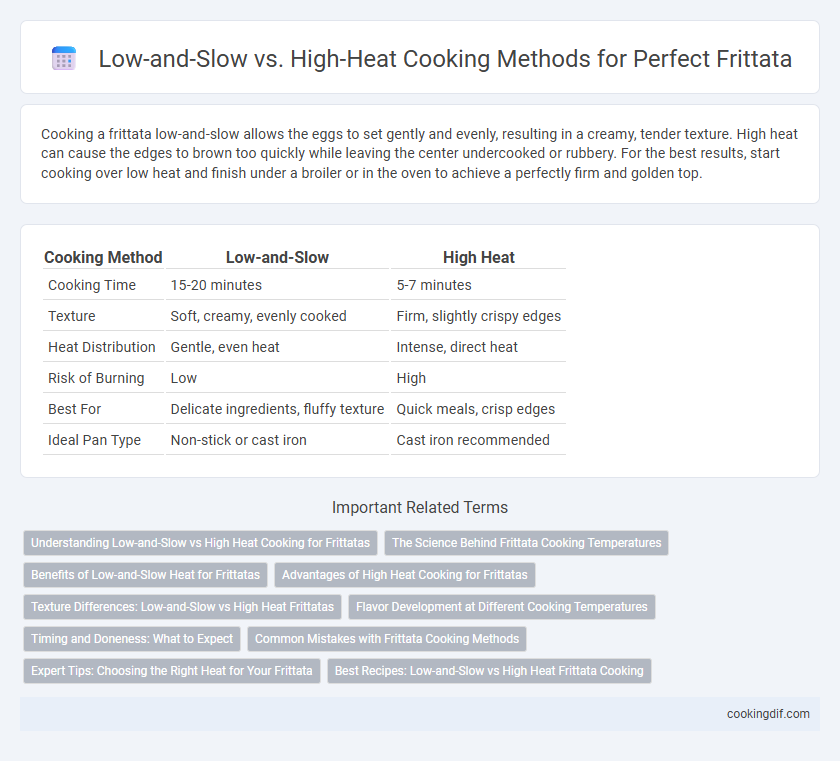Cooking a frittata low-and-slow allows the eggs to set gently and evenly, resulting in a creamy, tender texture. High heat can cause the edges to brown too quickly while leaving the center undercooked or rubbery. For the best results, start cooking over low heat and finish under a broiler or in the oven to achieve a perfectly firm and golden top.
Table of Comparison
| Cooking Method | Low-and-Slow | High Heat |
|---|---|---|
| Cooking Time | 15-20 minutes | 5-7 minutes |
| Texture | Soft, creamy, evenly cooked | Firm, slightly crispy edges |
| Heat Distribution | Gentle, even heat | Intense, direct heat |
| Risk of Burning | Low | High |
| Best For | Delicate ingredients, fluffy texture | Quick meals, crisp edges |
| Ideal Pan Type | Non-stick or cast iron | Cast iron recommended |
Understanding Low-and-Slow vs High Heat Cooking for Frittatas
Low-and-slow cooking allows the frittata to set evenly, preventing browning and ensuring a creamy texture by gently coagulating eggs without curdling. High heat delivers a rapid rise and a browned, crispy crust but risks uneven cooking and a rubbery interior. Mastering the balance between these methods is crucial for achieving a frittata with a tender, custardy center and a golden, slightly firm exterior.
The Science Behind Frittata Cooking Temperatures
Cooking a frittata on low-and-slow heat allows for even heat distribution, preventing the eggs from curdling and ensuring a creamy, tender texture by gently coagulating proteins. High heat accelerates cooking but risks overcooking the outer edges while leaving the center underdone, causing uneven texture and increased chances of browning or burning. Understanding the science behind these temperatures highlights that controlled, moderate heat optimizes protein denaturation and moisture retention, crucial for the perfect frittata.
Benefits of Low-and-Slow Heat for Frittatas
Cooking frittatas with low-and-slow heat ensures even cooking throughout, preventing the edges from burning while the center remains undercooked. This method preserves the fluffy texture and enhances the delicate flavors of eggs and added ingredients such as cheese, vegetables, or meat. Slow heat also reduces the risk of curdling, resulting in a creamy, tender frittata with consistent doneness.
Advantages of High Heat Cooking for Frittatas
High heat cooking for frittatas creates a golden, crispy crust while keeping the interior tender and moist, enhancing texture contrast. It significantly reduces cooking time, allowing for quick preparation without compromising flavor. This method also promotes even browning, which intensifies the savory taste and visual appeal of the dish.
Texture Differences: Low-and-Slow vs High Heat Frittatas
Cooking a frittata low-and-slow results in a creamy, custard-like texture with evenly cooked eggs and tender vegetables. High heat methods create a firmer, browned crust with a denser interior that can sometimes become rubbery if overcooked. For optimal texture balance, the low-and-slow technique gently cooks the frittata through, preserving moisture and softness.
Flavor Development at Different Cooking Temperatures
Cooking a frittata low-and-slow at around 300degF allows eggs to set gently, developing a creamy texture and enhancing the subtle sweetness of vegetables through prolonged heat exposure. High heat accelerates Maillard reactions on the outer edges, producing a rich, browned crust and intensified savory flavors but risks overcooking the interior. Balancing lower temperatures with a finishing broil can optimize flavor depth and texture contrast in frittata preparation.
Timing and Doneness: What to Expect
Cooking a frittata low-and-slow results in even doneness with a tender, custard-like texture, typically requiring 15 to 20 minutes on medium-low heat. High heat speeds up cooking to about 5 to 8 minutes but risks uneven doneness and a tougher, rubbery consistency. Monitoring internal temperature around 160degF ensures proper set without overcooking.
Common Mistakes with Frittata Cooking Methods
Using high heat often leads to overcooked, burnt edges while the center remains undercooked, a common mistake in frittata preparation. Cooking frittatas low-and-slow ensures even heat distribution, preventing curdled eggs and achieving a creamy, tender texture. Avoiding rapid temperature changes reduces the risk of cracking or collapsing, preserving the frittata's structure and appearance.
Expert Tips: Choosing the Right Heat for Your Frittata
Expert chefs recommend cooking frittatas low-and-slow over medium-low heat to ensure even heat distribution and prevent the edges from overcooking while the center remains underdone. High heat can cause rapid browning or burning, compromising texture and flavor balance. Opting for controlled, gradual heat allows the eggs to set uniformly, creating a tender and creamy frittata with perfectly cooked fillings.
Best Recipes: Low-and-Slow vs High Heat Frittata Cooking
Low-and-slow frittata cooking ensures even heat distribution, resulting in a creamy, custard-like texture by gently setting eggs without browning. High heat methods deliver a quicker cook time and a crispier, golden top but risk overcooking edges and undercooking the center. For best recipes, low-and-slow techniques excel in achieving uniform doneness, while high heat suits frittatas intended to have a crunchy crust and faster preparation.
Low-and-slow vs High heat for cooking method Infographic

 cookingdif.com
cookingdif.com